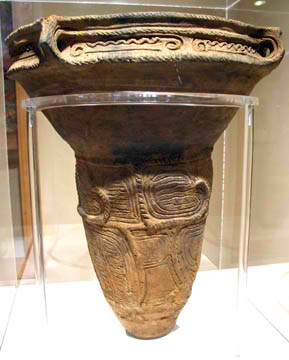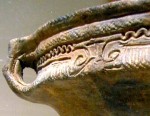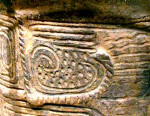


Unknown
Japanese
Jomon Jar, 15th c. BCE - 2nd c. BCE, late Jomon period
earthenware
SBMA, Museum Purchase from Ronald Robertson
1968.22
RESEARCH PAPER
The first Japanese ceramic wares date back as early as 10,500 to 10,200 BCE making them among the oldest ceramic wares in the world. The culture which produced them was named “Jomon” after the way its people decorated the surface of their ceramic vessels. Straw cord or ropes were pressed by hand (or “mon”) onto the surface to make “cord-like markings” or “Jo” or Joman.
In 1879, when he was conducting an archeological dig of the shell mounds in the“ O mori kaizuka” district of Tokyo, Edward Morse, a marine biologist teaching at the University of Tokyo, first discovered shards of these ceramics. The multiple layers of findings unearthed in his and subsequent archeological digs revealed that there were at least three periods of this earliest Japanese culture: the Early Jomon Period:10,500 BCE to t 2500 BCE; the Middle Jomon Period:2500 to1500 BCE; and Late Jomon Period:1500 to 300-250 BCE.
THE PEOPLE AND THEIR CULTURE
Some anthropologists suggest the Jomon people may have been Caucasians: coming from the northern India, through Asia and Siberia to Japan. Though their origin is still not confirmed, skeletal studies support that they are related to the modern Ainu, who still live in the far northern islands of Japan: the Sakhalin near Russia, the Kurile Islands, and Hokkaido.
Evidence suggests these Jomon people once lived in all parts of Japan, but the richest archeological findings come from the mountain regions in Central Honshu, Nagano, and Yamanashi. During warming periods near the beginning of the Middle Period (2500 to 1500 BCE), the Jomon people moved into the cooler regions of the mountains and settled in small family groups in pit houses that were arranged their campsites into “rudimentary” villages. Here, they were free from attacks that plagued the coastal settlements of this time. In the summers, the rivers and streams provided plenty of fish and the forest provided nuts, roots and berries. There is even some evidence that they grew yams, taro, and lily bulbs. It was only the bitter cold winters in the “neo-glaciations period” around 1500 BCE that drove them back to the coasts. There they intermarried and were eventually dominated by the Yayoi peoples who came from Korea and started the next great Japanese culture in lasting from about 250 BCE to 250 CE.
The SBMA Jomon Jar came from the earliest part of the Late Jomon Period and was created about the same time as the SBMA Chinese Neolithic Jar. The Chinese Jar, like wares from other Neolithic cultures, was created for storage ( as well as for funerary purposes) and is thought to signify that people were settling into an early agricultural type of society. By contrast, the Jomon Jars were made for cooking and were used by people still living in a migratory hunter/gather type of society. The loops around the rim, permitted the jar to be strung on poles and carried from campsite to campsite.
Though thought of mostly as utilitarian, some archeologist suggest wares like the SBMA Jomon Jar may also have served some part in ritual life of the peoples. In the later part of the Middle Jomon Period, it was increasingly common that “kami” or spirit like figures with big eyes and heart shaped faces were stretched up from the clay which formed the loops and rim. (NOTE: “Kami” are defined by Edward Schafer in Symbols of Japan as a “spiritual force or energy emanating from the object; that comes from even seemingly inanimate objects like stones.” These figures were thought of as shamans and were there to ward off nature’s extremes and help the people survive. (Arts of Japan).
Other anthropologists suggest these decorated Joman Jars may have been used in ceremonies for burying children. However, since none have been found at grave sites, it is assumed they were not created specifically as funerary objects.
The most likely clue to their ritualistic value is in the ropes which decorate them. From the earliest Japanese and Shinto mythologies, ropes have long been assumed to have magical and religious powers. Knots formed by two ropes intersecting are considered special barriers or defenses against evil spirits. In the Shinto purification ceremony, the white fabric rope belts (shimenawa) can only be worn by grand champions of the Sumo Arts. The term for a champion Sumo wrestler is “ yokozuna” which means “horizontal rope”. In Buddhist beliefs, ropes (saku or kensaku) are said to be used by deities to lead lazy believers to salvation. Even today, the silk chords used to tie packages is thought to make them even more precious.
THE DISTINCT STYLES OF THE THREE JOMON PERIODS:
As they were used mostly for cooking, the Early “Jomon” Jars were pointed on the bottom so they could be wedged between the rocks of the fire pit. Their shapes were simple. Only small random scratch markings or imprints from twisted plant fibers, seashells, or bamboo stalks were pressed into the sides to decorate them. As a group, the earliest Jars do not have the same playful rhythmic movement to the shape or conscious pattern to the surface designs that distinguish the later Middle and Late Jomon Period wares.
The SBMA vessel belongs to the earliest part of the Late Jomon period. Made flat on the bottom so it could stand by itself in the fire, this deep cylindrical bottom would have been buried in the ground to retain the heat, while the slanted portion might set against the fire for cooking: much like a modern day wok. The black smudged areas in this slanted portion seem to have been burned from the fire. Because it is flat bottomed, vessels like this may also have been used for food storage when encamped in the villages.
The hand made designs (mon) on the sides of the vessel form a consciously organized design and demonstrate the distinctive “Jomon” design for which the culture has it’s name. The basket weave or straw chord patterns were incised and then bounded by protruding bands which look like three dimensional ropes (Jo).
As was typical in the late Middle Period Jars, the form of the rim became much more plastic: curvilinear or even sometimes exaggerated into scallops. The shape and wavy lines incised just under the rim as are seen on the rim of the SBMA Jar are somewhat like the wave like patterns found in other cultures of these times: again like the SBMA Chinese Neolithic Jar and in the bronze wares. Since the tops of the carrying loops are broken off on the SBMA jar, we do not know if “kami” once protected it. We can only imagine they might have.
Gradually during this Late Jomon Period, the shapes became very plastic and fanciful, as if the “kami” took over the whole shape. Then, in extreme contrast, the latest vessels became uniform in shape, even refined, and were finished in a much more formal and consistent way: implying that there was a standardized aesthetic which directed the creative process. The later wares were also probably fired longer or in hotter fires. Areas of black sheen were consciously placed almost “like paint” to enhance the design, rather than allowed to occur as random patches as can be seen on the earlier jars like the SBMA Jar.
MATERIAL AND TECHNIQUE
The Jars were made of a coarse local clay which has random metallic markings in the reddish and yellow body. They were coiled to form the “jar” shape, and then smoothed by hand.
The rim was then pulled and either formed into the various curvilinear shapes or incised with wavy lines like those on the SBMA Jar. Also, at this time, the loops were stretched from the rim and holes were punched through them to be used for carrying the Jar.
Then impressions of various objects were pressed or etched into the sides. The basket like pattern was made by wrapping a rope cord around a stick and pressing it in to the wet clay. After this, the protruding bands, were rolled, abraded and attached with a wet slurry of clay: formed themselves to look like ropes. They were added to separate the various patterned areas and the intersections where the ropes crossed were made even more pronounced.
Once formed, the vessels were fired at a very low temperature in open pits in the ground. In some places where the fire was hot enough, the metallic particles fused to make a shiny or grayed self-glaze like we see in the zone between the columnar base and the band that is the rim. As you look at the SBMA Jar, on the far left it is possible to see an area where a different type of clay was added: it is redder and has no granite flecks scattered through it as does the rest of the Jar. On the right side of the Jar, there appears to be a mend in the Jar.
THE ARTISAN:
As would be common in most hunter/gatherer cultures, it is believed that the artisans were women.
Unlike the shape and decoration on the SBMA Chinese Neolithic Jar which was standardized, each Jomon vessel is quite distinctive both in shape and design and expresses that artist’s own unique creative ideas. Looking at the sides of the Jar and moving around from the far left to the front of the SBMA Jar, it is possible to see that the artist first did a striped pattern, then did a dotted pattern and then returned to the striped pattern in these areas between the three dimensional ropes. As we observe this, the unique hand of the artist is made visible today!
SUMMARY:
The Jomon wares suggest an aesthetic that prefers asymmetrical forms, randomness to pattern, and swirling kinds of patterns. These same principles became the basis of the early Shinto and Zen Buddhist art that is still considered the high art of Japan. Composed more by intuition than to replicate some standardized principle: the variety of Jomon wares also suggest that visual design was considered a meaningful activity in their culture, long before any outside influences from Chinese, Korean, or Buddhist aesthetics were applied to the arts of Japan.
As nothing similar has been found in either the Middle East or Asia, the SBMA Jomon Jar represents art that is distinctively Japanese. But this Jar also celebrates something universal: the basic human drive to make even functional things beautiful!
Prepared for the SBMA Docent Council by Gail Elnicky/Niki Bruckner: December 2004
Bibliography
Merrily Baird, Symbols of Japan, New York: Rizzoli International Publications, Inc. 2001.
Louis Frederic. Japan Encyclopedia Cambridge, Massachusetts: The Belknap Press of Harvard University Press, 2002.
Hazel H. Gorham Japanese Oriental Ceramics, Rutland, Vermont: Charles E. Tuttle Company, 1971.
Penelope Mason *History of Japanese Art, New York: Harry N. Abrams, Inc.,1993.
Hugo Munsterberg The Arts of Japan: An Illustrated History, Rutland, Vermont: Charles E.Tuttle Company, 1957.
Noma Seiroku, The Arts of Japan; Ancient and Medieval Volume 1, Tokyo, Japan: Kodansha International, LTD., 1975.
Peter C. Swann, Editor, 2000 Years of Japanese Art , New York: Harry N. Abrams, Inc.,
